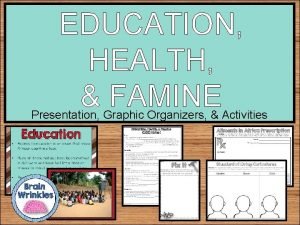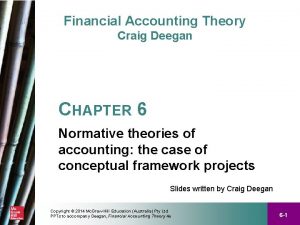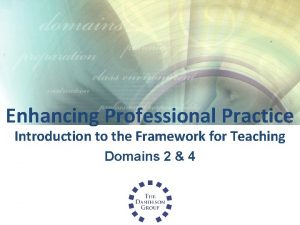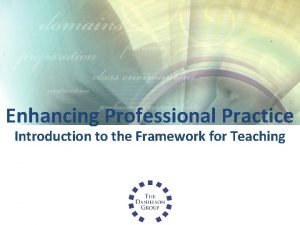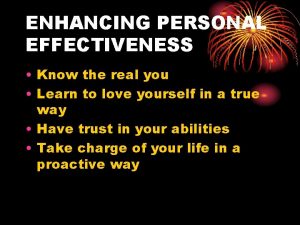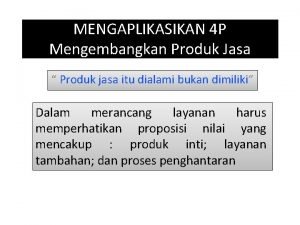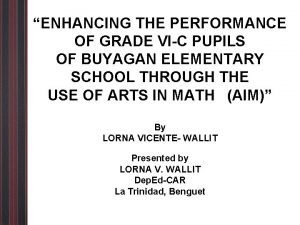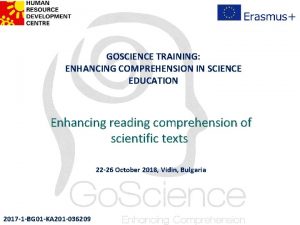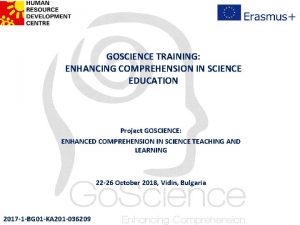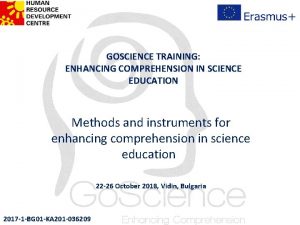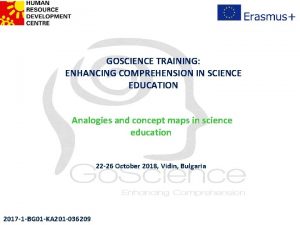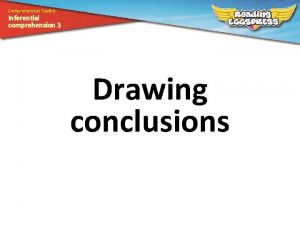GOSCIENCE TRAINING ENHANCING COMPREHENSION IN SCIENCE EDUCATION Enhancing








- Slides: 8

GOSCIENCE TRAINING: ENHANCING COMPREHENSION IN SCIENCE EDUCATION Enhancing listening comprehension in science education 22 -26 October 2018, Vidin, Bulgaria 2017 -1 -BG 01 -KA 201 -036209

Listening comprehension • Listening comprehension encompasses the multiple processes involved in understanding and making sense of spoken language. These include recognizing speech sounds, understanding the meaning of individual words, and/or understanding the syntax of sentences in which they are presented. • Listening comprehension is the ability to know the words, which one hears and relate to them in some way, based on his/her prior knowledge and experience. Good listening comprehension allows the listener to understand the information he is presented, remember it, discuss it, and even retell/present it in his own words. • Listening comprehension also refers to recognizing the rhythmic-melodic elements of the speech - the emphasis, the intonation, the length of the vocals, etc. and making relevant conclusions based on context, real-world knowledge, and speaker -specific attributes (e. g. , to what information the speaker has access and about what he/she is likely to be talking).

Levels of listening comprehension • • • Discriminative listening is foundational to the other levels. Discriminative listening is being able to listen to pertinent sounds as well as being able to distinguish between verbal and nonverbal cues. Precise listening helps ascertain specific information. Teaching children how to recall details, how to paraphrase information, how to follow spoken directions are the types of skills that call for precise listening. Strategic listening is basically helping students listen for understanding. Teaching students how to connect the ideas they are hearing with their prior knowledge about the topic, how to summarize information, how to compare and contrast information, and how to make inferences are skills associated with strategic listening. This level calls on listeners to concentrate on the intended meaning. Critical listening is all about helping learners not only comprehend the spoken message, but how to evaluate it. They are able to scrutinize and analyze the message, looking for logic and statements that either support or negate the stated message, in order to be convinced that the speaker is credible. Teaching students how to recognize bias, distinguish among fact and opinion, and detecting propaganda techniques are skills that enable them to listen critically. Appreciative listening is appreciating the overall style of the speaker and is fairly individualistic. As we listen at this level, different aspects of what we are hearing catch our attention. This is why some might enjoy listening to some types of poetry, songs, musical scores more so than others. Teaching students how to recognize the power of language, appreciate oral interpretations, and understand the power of imagination are ways to help learners become appreciative listeners.

Development of listening comprehension • • The role of the teacher: – engage the students; make them pay attention to what you say; – pay attention to the scientific language used Strategies to convey meaning: 1. Analogy Strategies to convey meaning Speaker draws a parallel to another, potentially more familiar concept to explain the scientific concept. Illustration Speaker gives several examples to illustrate a concept. Explanation Attempt by the speaker to define a scientific jargon word he/she uses. Colloquialism A simplification of a scientific concept in everyday language that does not have a precise scientific meaning.

Development of listening comprehension Strategies to improve students’ attention towards spoken words 1. Drama: – Make a Story: The goal is to make a seamless story among various players. Have a group of 6 to 10 students line up in a row. Start by getting a suggestion from the audience. (“May I have the title of a story that’s never been written…? ? ? ”) After receiving the suggestion (i. e. “The Best Science Class Ever”), repeat it back – this is to ensure that the players have heard it. The Conductor points at one player who starts telling the story and keeps talking until The Conductor points at someone else. Have the next player pick up where the last improviser left off – have them do it as seamlessly as possible (even if it’s mid-word or midsentence). Keep pointing at players and telling the story until you feel it is done. 2. DICTATION: Dictation works are among the activities to be done with the aim of developing students' listening skills. Students are supposed to listen in dictation works. Reading a text to be dictated by dividing into appropriate lengths and repeating parts read will help students to focus their attention

Development of listening comprehension Strategies to improve students’ attention towards spoken words 3. Word games: • • Time to talk: It is important to promote students’ dialogue as they have instructional conversations. We need to provide students with opportunities to use their colloquial language and translate back and forth with scientific and technical terms. We can use this strategy, called interlanguage, to discuss the different explanations of the students’ experiences in the classroom. For example: – Student: “We put this smooth powder in the bag along with the crunchy powder and the bag blew up and got hot. ” – Teacher: “We mixed baking soda and calcium chloride with water resulting in a gas, and heat was released. ” – Scientist: “The combination of baking soda and calcium chloride is an exothermic reaction with the products of sodium chloride, calcium carbonate, and carbon dioxide. ” Matching pairs. Students are given a stack of cards and asked to match a term with its associated function, symbol, scientific name, etc. For example, a stack might include cards with the names of body parts and other cards that name the body parts’ functions. Students match each part to its appropriate function.

GOSCIENCE. EU https: //www. facebook. com/ goscienceproject/ 2017 -1 -BG 01 -KA 201 -036209

Thank you for your attention! „This project has been funded with support from the European Commission. This publication [communication] reflects the views only of the author, and the Commission cannot be held responsible for any use which may be made of the information contained therein. ”
 What is your favorite subject answer
What is your favorite subject answer Africa's economic systems comprehension check answer key
Africa's economic systems comprehension check answer key Four enhancing qualitative characteristics
Four enhancing qualitative characteristics Enhancing professional practice
Enhancing professional practice Charlotte danielson framework
Charlotte danielson framework Enhancing personal effectiveness
Enhancing personal effectiveness Contoh pengembangan produk jasa
Contoh pengembangan produk jasa Enhancing thermal conductivity of fluids with nanoparticles
Enhancing thermal conductivity of fluids with nanoparticles Enhancing the performance of grade vi-c
Enhancing the performance of grade vi-c

